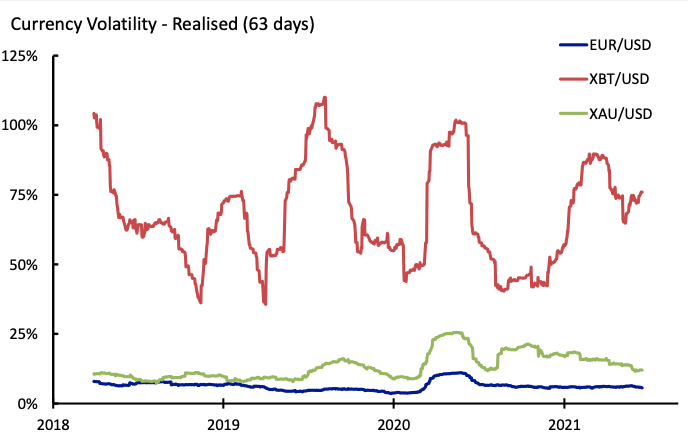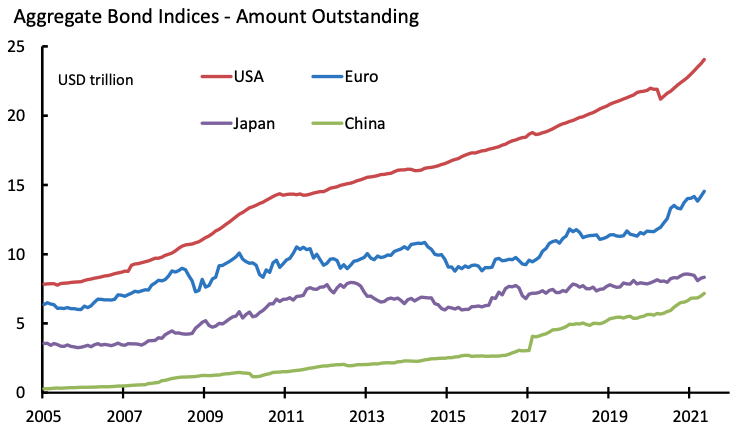When it comes to central bank digital currencies (CBDCs), the focus of market participants and regulators is mainly on optimal design and the risk of disruption for the banking sector (Andolfatto 2019, Auer et al. 2020, Bindseil and Panetta 2020, Niepelt 2020). Instead, in this column we concentrate on the geo-strategic implications of central bank digital currencies, including the key business of foreign exchange reserves. As the digital revolution implies the need for countries to develop a new arsenal of strategic assets, such currencies are likely to become a key instrument on the geopolitical chessboard.
Digital reserve currencies: Survival of the fittest
The IMF defines foreign exchange reserves as “official public sector foreign assets that are readily available to and controlled by the monetary authorities” (IMF 2001). This definition lends itself to be extended to the best practices of reserve management, like prudent liquidity and credit risk management or the generation of a steady cash flow. Would a digital currency, or more generally a digital asset, qualify as a reserve instrument? So far, only a very limited subset of the existing asset universe enjoys reserve status. According to the IMF, worldwide allocated reserves amounted to $11.9 trillion at the end of 2020, of which roughly 80% were denominated in either US dollars or euros.
To tackle the question about reserve status, it might be worth taking a step back to recall the classic functions of money: means of payment, measure of value, and store of value. Ideally, money is a fungible, durable, portable, and identifiable medium with a stable value. To put it bluntly: “money is the most universal and most efficient system of mutual trust ever devised… even people who do not believe in the same god or obey the same king are more than willing to use the same money” (Harari 2015). With the digital revolution, money has acquired an additional new function: a store of information. In a cashless society – admittedly an extreme case – any exchange between two counterparties generates information about the counterparties themselves, thus implying a tradeoff between the value of privacy/anonymity and the value of a digital marketplace.
As one of us argued in a recent paper (Tentori 2021), central bank digital currencies are a natural evolution of existing forms of money that satisfy all four characteristics of money described above. Furthermore, central bank digital currencies are designed to maximize the store of information function. On the other hand, cryptos and private stablecoins might tick some of the boxes as well, but not all (Rosa and Tentori 2021). In particular, these ‘private’ digital assets are subject to excessive levels of volatility (Figure 1), questioning their function as a store of value (Cœuré, 2019).
Figure 1 Bitcoin’s excessively volatile compared to gold or the euro
Source: Bloomberg
Not all digital assets operate with a backstop. The backstop – a digital currency’s collateral framework – is key in order to distinguish ‘stablecoins’ from the broader ecology of digital currencies. It is an essential design feature, one likely to influence the path of adoption of any nascent digital currency. One could object that after the collapse of the gold standard, the value of traditional currencies is only implicitly backed by the sovereign (e.g. via tax revenues or net wealth). Credibility, trust and confidence are therefore essential features of traditional and digital currencies alike.
Following this, we tend to regard central bank digital currency as a superior instrument in the context of (digital) reserves management. We deem other digital solutions at risk of being crowded out by central bank digital currencies. In this respect, we appreciate the global central banks’ efforts to design and test digital liabilities, as monetary policy transitions into the digital realm. At present, 80% of the world’s central banks are currently engaging in central bank digital currency research and development (Auer at al. 2020), including the ECB, the People’s Bank of China, and the Federal Reserve.
Digital sovereignty: Central bank digital currencies are a new strategic asset
The concept of sovereignty is often defined as a supreme authority within a territory. Identifiable signs like a flag or a currency typically outline the sovereign’s sphere of influence. Just like issuing and operating a traditional currency is a sign of monetary sovereignty, so is central bank digital currency’s issuance a way of reasserting monetary sovereignty over a country’s cyberspace. Unfortunately, the concept of sovereignty is hard to grasp in cyberspace. The meaning of territory and authority is increasingly diluted as data gets stored outside a state’s geographical and physical borders. We would argue that in a not-too-distant future governments will be forced to secure ownership of and access to their citizens’ strategic data, even when stored via cloud technology. Rosa (2020) suggests that the armies of the future might include strategic digital assets like cyber divisions, and that “private-sector companies will play a crucial role, just as private contractors do today in traditional conflicts”.
Without dwelling excessively on the matter of cyber warfare, it seems rather unlikely that central bank digital currencies will be spared from cyberattacks. From the point of view of the information function of money, opening up a central banks’ balance sheet to the general public might generate huge privacy costs in case of a data breach. A cyberattack could represent a violation of both digital and traditional sovereignty akin to a digital-era declaration of war. As a result, we would expect the strategic importance of central bank digital currencies to put pressure on governments to re-shape and adapt their diplomatic framework.
Central bank digital currencies could also become a valuable strategic asset on more traditional macroeconomic grounds. In fact, like in every strategic game – including geopolitics – governments aim to exploit a potential ‘first-mover advantage’. For some central banks, time itself appears to be an existential asset in the digital currency race. In fact, modelling the introduction of a central bank digital currency in an international interest parity environment might partially explain central banks’ interest in this policy instrument. As suggested by Ferrari et al. (2020), “a CBDC increases asymmetries in the international monetary system by reducing monetary policy autonomy in foreign economies, but not domestically, suggests in addition that introducing a CBDC sooner, rather than later, could give rise to a significant first-mover advantage”.
Digital future: China leads the race
Two countries have made the largest progress in the development of central bank digital currencies: China and Sweden. While Sweden does not seem ready to fully roll out its digital currency in the medium term, China’s ‘DCEP’ system was conceived six years ago and is now in its experimentation phase – with local tests being conducted in Shenzhen, Suzhou, Xiongan, and Chengdu. Tests have been conducted in the pubic as well as the private economy (including several international companies).
From the point of view of domestic policy, central bank digital currencies are a valuable asset for two main reasons:
- Information: Being able to record every transaction that takes place in a cashless society is an appealing proposition for any government looking to leverage both its fiscal efficiency and its ability to control the population.
- Monetary policy: Being able to pass negative interest rates on the household sector is likely to improve a central bank’s monetary transmission, albeit not without a potential cost in terms of financial stability (Schilling et al. 2020)
China is also active on the international front – for example, by addressing the issue of cross-border payments using its own central bank digital currency technology. In this respect, Beijing has joined the BIS Innovation Hub and Hong Kong Monetary Authority Bridge initiative and their proof-of-concept prototype for wholesale cross-border payments. China had already begun a process of internationalisation of its currency way before the digital currency project was conceived. The Chinese financial market is evolving rapidly – its government debt is in the process of being added to major bond indices and it is becoming a serious competitor to established liquid sovereign issuers.
Figure 2 China’s bond market is systemically relevant
Source: Bloomberg
The introduction of China’s digital currency will likely represent an acceleration of existing trends. It is relatively straightforward to imagine that China will ‘incentivise’ the adoption of its own digital currency in countries within the Belt and Road Initiative (BRI) and Asian Infrastructure Investment Bank (AIIB). Similarly, it will likely offer its digital platform to countries joining the Regional Comprehensive Economic Partnership (RCEP).
China is now openly campaigning for the adoption of its own governance model (a mix of state capitalism, freedom of enterprise, and political authoritarianism), especially in South-East Asia – a region that has experimented with democracy, with ambiguous results (Giordani 2021). In this respect, we anticipate that central bank digital currencies might play a key role in a wider portfolio of strategic assets, ready to be deployed on the geopolitical arena.
References
Andolfatto, D (2019), “Central bank digital currencies and private banks”, VoxEU.org, 17 March.
Auer, R, G Cornelli and J Frost (2020), "Central Bank Digital Currencies: Drivers, Approaches and Technologies”, VoxEU.org, 28 October.
Bindseil, U and F Panetta (2020), “Central Bank Digital Currency Remuneration in a World with Low or Negative Nominal Interest Rates”, VoxEU.org, 05 October.
Cœuré, B (2019), “Update from the Chair of the G7 Working Group on Stablecoins”, speech, BIS.
ECB (2020), Report on a Digital Euro.
Ferrari, M M, A Mehl and A Stracca (2020), “Central Bank Digital Currency in an Open Economy”, ECB working paper 2488.
Giordani, M (2021), “Democracy Eroding Fast in South East Asia”, Rosa and Roubini Associates.
Harari, Y N (2015), Sapiens: A Brief History of Humankind, New York, NY: Harper.
IMF (2001), “Guidelines for Foreign Exchange Reserve Management”.
Niepelt (2020), “Digital Money and Central Bank Digital Currency: An Executive Summary for Policymakers”, VoxEU.org, 03 February.
Rosa, B (2020), “Data Laws or Data Wars, The World Today”, Chatham House 76(2): 36-37.
Rosa, B and A Tentori (2021), “Central Bank Digital Currencies, Reserve Currencies and Geopolitics”, AXA Investment Managers.
Schilling, L, J Fernández-Villaverde and H Uhlig (2020), “Central Bank Digital Currency: When Price and Bank Stability Collide”, NBER working paper 28237.
Tentori, A (2021), “Central Bank Digital Currency: Policy and Design”, AXA Investment Managers.





